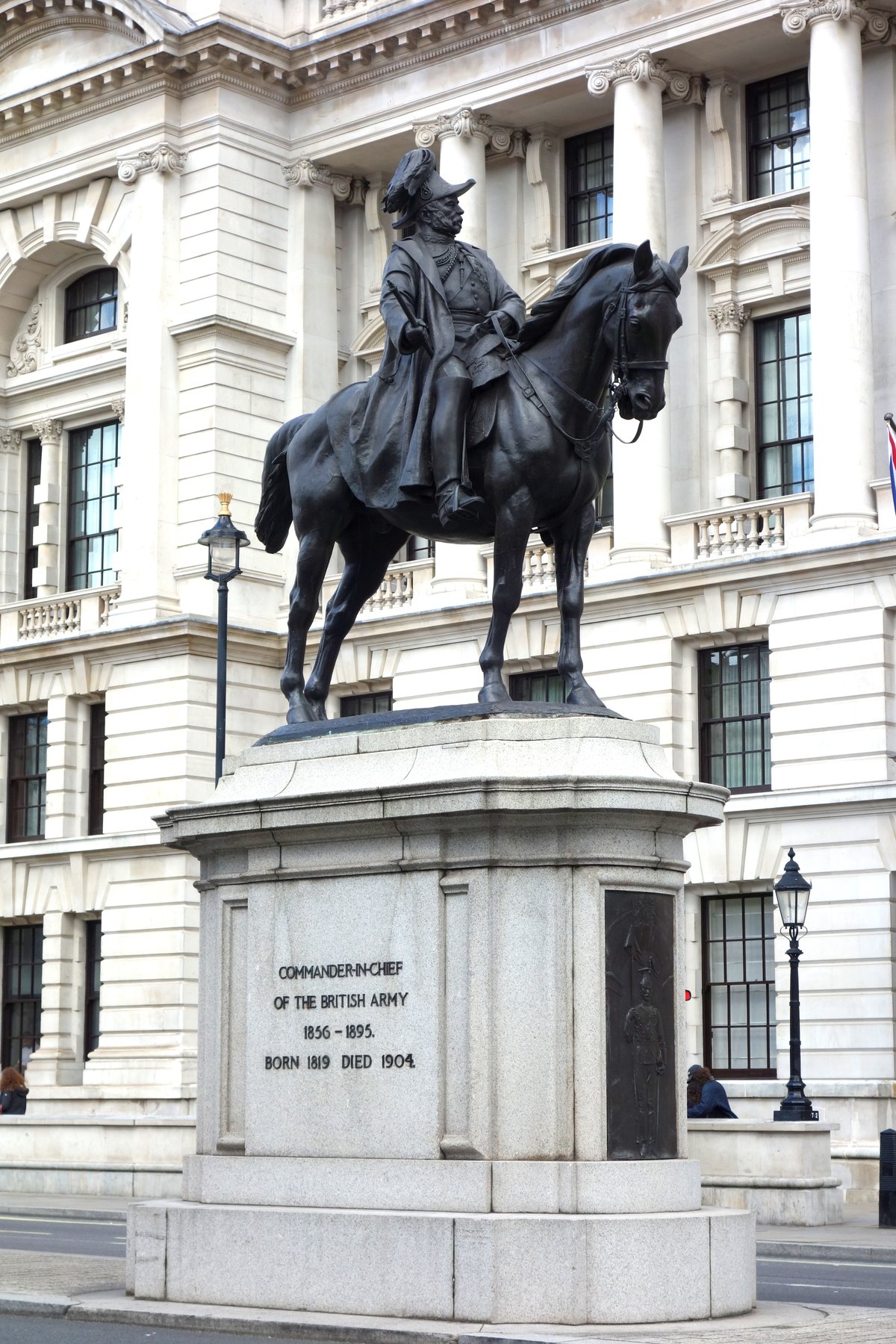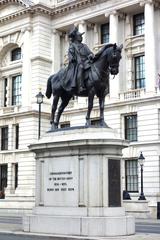
Equestrian Statue of the Duke of Cambridge, London: Visiting Hours, Tickets, and Travel Guide
Date: 14/06/2025
Introduction
Nestled in the historic heart of London’s Whitehall, the Equestrian Statue of the Duke of Cambridge stands as a prominent tribute to Field Marshal Prince George, Duke of Cambridge (1819–1904). This monument, crafted by Adrian Jones and unveiled in 1907 by King Edward VII, captures the essence of Victorian-era military heritage and the enduring legacy of British royal leadership. Freely accessible at all hours, the statue draws history enthusiasts, art lovers, and casual tourists alike, serving as both an artistic marvel and a gateway to exploring London’s rich military and political heritage.
For planning your visit, including updated event details and guided tours, consult resources like the Visit London Whitehall attractions and the Horse Guards Parade official site. This comprehensive guide offers everything you need to know to make your visit to the Equestrian Statue of the Duke of Cambridge both informative and memorable.
Table of Contents
- Overview of the Duke of Cambridge Statue
- Visiting Hours and Access
- How to Get There
- Accessibility Information
- Guided Tours and Special Events
- Photography Tips
- Nearby Attractions
- Historical Background and Legacy
- Artistic Design and Symbolism
- Plan Your Visit
- Frequently Asked Questions (FAQ)
- References
Overview of the Duke of Cambridge Statue
The statue commemorates Prince George, Duke of Cambridge, who served nearly four decades as Commander-in-Chief of the British Army. Designed by Adrian Jones, renowned for his lifelike animal sculptures, the statue depicts the Duke in full military regalia, astride a dynamic charger. Its granite plinth and detailed bronze work celebrate his ties to regiments like the Grenadier Guards and 17th Lancers, while symbolizing the tension between military tradition and reform during the Victorian era.
Visiting Hours and Access
- Hours: The statue is located outdoors on Whitehall and is accessible to the public 24/7, year-round.
- Tickets: There is no entry fee or ticket required, making it an ideal stop for all visitors.
How to Get There
- Underground: The nearest Tube stations are Westminster (Jubilee, Circle, District lines) and Charing Cross (Bakerloo, Northern lines), both within a 5–10 minute walk.
- Bus: Major bus routes including 11, 24, and 148 serve Whitehall.
- On Foot: The statue is within walking distance of Trafalgar Square, Parliament Square, and other major landmarks.
- Cycling: Cycle lanes connect Whitehall to other central London districts.
- Driving: Limited street parking is available; public transport is recommended due to congestion charges. (Transport for London)
Accessibility Information
Whitehall and the area around the statue offer step-free access, wide pedestrian paths, and dropped kerbs. The statue itself is mounted on a raised plinth, but is easily viewed from surrounding pavements. Accessible toilets can be found at nearby stations. (Accessible London)
Guided Tours and Special Events
The statue is featured in many walking tours exploring Whitehall’s military and political landmarks. Special events, such as the Trooping the Colour and Remembrance Sunday, often incorporate the statue into ceremonial routes. For current schedules, see Royal Family Events and Walks in London.
Photography Tips
- Best Light: Early morning and late afternoon offer optimal lighting and fewer crowds.
- Angles: Capture the statue’s dynamic pose with Horse Guards Parade or Whitehall’s historic buildings in the background.
- Etiquette: Tripods are permitted but must not obstruct walkways. Be mindful of pedestrian and vehicular traffic.
Nearby Attractions
- Horse Guards Parade: The site of daily Changing of the Horse Guards and the annual Trooping the Colour.
- The Cenotaph: National war memorial located on Whitehall.
- The Banqueting House: The only surviving part of the Palace of Whitehall.
- Downing Street: The official residence of the UK Prime Minister.
- The Women of World War II Memorial: Honoring women’s roles during WWII.
- The Guards Memorial: Commemorates soldiers of the Guards Division killed in WWI.
- The National Gallery and Churchill War Rooms: Both within a 15-minute walk.
For more, see Visit London.
Historical Background and Legacy
Prince George, Duke of Cambridge, was a grandson of King George III and key figure in 19th-century British military history. Educated in Hanover and England, he embarked on a distinguished army career, ultimately serving as Commander-in-Chief from 1856 to 1895. The Duke was known for his staunch conservatism and resistance to army reforms, working closely with Queen Victoria to uphold traditional structures. While his influence preserved many aspects of British military tradition, it also contributed to organizational weaknesses that became evident in later conflicts. He died in 1904, with the statue erected three years later to commemorate his complex legacy.
His name also endures in institutions such as the Cambridge Military Hospital in Aldershot, and streets like George Road and Cambridge Road in Kingston Vale and Norbiton.
For further reading, consult the Historic England listing.
Artistic Design and Symbolism
Adrian Jones, the sculptor, was celebrated for his ability to capture the vitality and dignity of horses. The 7.6-meter-high statue depicts the Duke in full field marshal regalia, complete with medals and insignia, symbolizing his high rank and royal honors. The bronze figure stands atop a granite plinth, which features bas-relief panels illustrating the Duke’s affiliations with regiments such as the Grenadier Guards and 17th Lancers.
The Duke’s upright posture and the horse’s alert stance evoke martial authority and readiness, while the baton in his hand references the one presented to his father by King William IV, highlighting the hereditary nature of military command. The use of Dartmoor granite for the plinth connects the monument to the British landscape, reinforcing its national significance.
Plan Your Visit
- When to Go: Daylight hours are recommended for best viewing and safety.
- Combine Your Visit: The statue is ideally located for inclusion in walking tours of Westminster, Whitehall, and surrounding landmarks.
- Refreshments: Numerous cafés and pubs are located nearby, including The Silver Cross and The Clarence.
Frequently Asked Questions (FAQ)
Q: What are the visiting hours?
A: The statue is accessible 24/7, year-round.
Q: Is there an admission fee?
A: No, it is free to visit.
Q: Is the statue wheelchair accessible?
A: Yes, the surrounding area is step-free and accessible.
Q: Are guided tours available?
A: The statue is included in many Whitehall and Westminster walking tours.
Q: Can I take photographs?
A: Yes, photography is encouraged. Please avoid blocking pedestrian paths.
Q: Are special events held nearby?
A: Yes, including the Changing of the Horse Guards and national ceremonies.
Conclusion and Call to Action
The Equestrian Statue of the Duke of Cambridge offers a window into Victorian military history, royal heritage, and the evolution of public art in London. Its central location, free access, and proximity to other major sites make it an essential stop for any visitor. For enhanced experiences, consider using resources like the Audiala app or joining a guided tour. Respect the monument by not climbing on it or leaving litter, and enjoy exploring the surrounding historic district.
Plan your visit today and immerse yourself in the rich narratives of London’s past at the Equestrian Statue of the Duke of Cambridge. For more information and updates on events, consult Visit London and Historic England.
References
- Visiting the Duke of Cambridge Statue in London: Hours, History, and Travel Tips, 2025, Audiala (https://www.audiala.com/duke-of-cambridge-statue-london)
- Discover the Equestrian Statue of the Duke of Cambridge: Visiting Hours, Tickets, and Historical Insights, 2025, Audiala (https://www.audiala.com/equestrian-statue-duke-of-cambridge)
- Visiting the Equestrian Statue of the Duke of Cambridge: Hours, Tickets & Nearby London Historical Sites, 2025, Audiala (https://www.audiala.com/visiting-duke-of-cambridge-statue)
- Your Complete Guide to Visiting the Equestrian Statue of the Duke of Cambridge: Hours, Access, and Cultural Insights, 2025, Audiala (https://www.audiala.com/complete-guide-duke-of-cambridge-statue)
- Visit London - Whitehall and Westminster Attractions
- Horse Guards Parade Official Site
- Historic England listing
- London Remembers
- Transport for London
- Accessible London
- Royal Family Events
- Walks in London
- Westminster City Council




















































































































































































































































